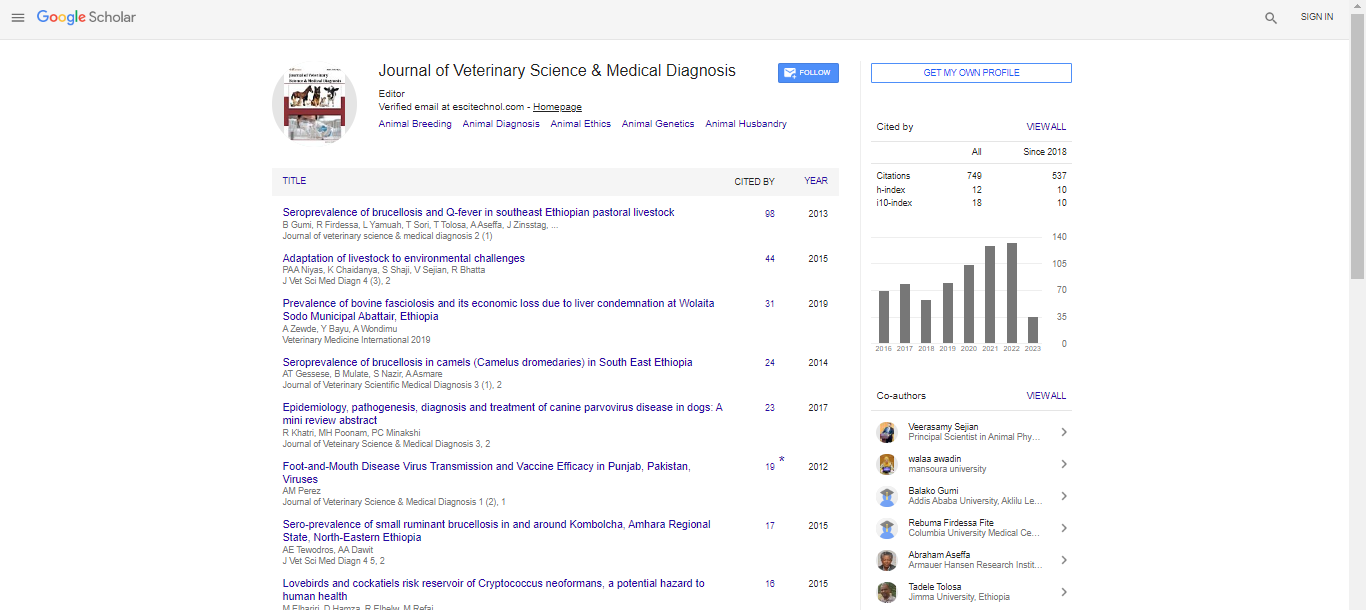Commentary, J Vet Sci Med Diagn Vol: 13 Issue: 2
Surgical Approaches for Treating Traumatic Injuries in Veterinary Medicine
Susan Martha*
Department of Veterinary Sciences, University of Toronto, Toronto, Canada
- *Corresponding Author:
- Susan Martha
Department of Veterinary Sciences,
University of Toronto,
Toronto,
Canada;
E-mail: sus@yahoo.com
Received date: 13 March, 2024, Manuscript No. JVSMD-24-154233;
Editor assigned date: 15 March, 2024, PreQC No. JVSMD-24-154233 (PQ);
Reviewed date: 29 March, 2024, QC No. JVSMD-24-154233;
Revised date: 09 April, 2024, Manuscript No. JVSMD-24-154233 (R);
Published date: 16 April, 2024, DOI: 10.4172/2325-9590.1000095
Citation: Martha S (2024) Surgical Approaches for Treating Traumatic Injuries in Veterinary Medicine. J Vet Sci Med Diagn 13:2.
Description
Traumatic injuries in animals, whether due to accidents, falls, or violent impacts, are a common cause of emergency veterinary care. The severity of these injuries can range from minor fractures to lifethreatening trauma, requiring urgent and skilled surgical intervention. In veterinary medicine, surgical approaches to treating traumatic injuries aim to stabilize the animal, restore function and improve quality of life. This essay explores the various surgical approaches employed by veterinarians to treat traumatic injuries, focusing on fractures, soft tissue injuries and internal trauma. Traumatic injuries often extend beyond fractures and soft tissue injuries to internal trauma, such as ruptured organs, internal bleeding, or damage to the abdominal cavity.
Fractures are among the most common traumatic injuries treated in veterinary medicine. Surgical intervention is often necessary when fractures involve displacement of bone fragments, instability, or when non-surgical methods like splinting or casting are inadequate. The primary goal in treating fractures is to ensure proper alignment and stabilization of the bone to promote healing and restore function. For fractures of the limbs, intramedullary pinning can be employed. In this method, a metal rod is inserted into the medullary cavity and it acts as a support to keep the bone aligned as it heals. This technique is particularly useful for fractures of the long bones in animals like dogs and cats.
One of the most common surgical techniques used in fracture management is Open Reduction and Internal Fixation (ORIF). In this procedure, the veterinarian makes an incision to directly access the fractured site, realigns the bone fragments and stabilizes them using implants such as plates, screws, or pins. These implants help hold the bones in place during the healing process. For more complex fractures, such as comminuted fractures (where the bone is broken into several pieces), external fixation may be used. External fixators involve the use of pins or wires that are inserted into the bone but connected to a frame outside the body, allowing for better stabilization without the need for internal implants.
For ligament and tendon injuries, such as torn cruciate ligaments in the knee, surgical repair may involve techniques like ligament stabilization surgery. In some cases, an autograft (a graft taken from the animal’s own body) or allograft (a graft from a donor animal) is used to reconstruct the torn ligament or tendon. One example is the TTA (Tibial Tuberosity Advancement) procedure for treating ruptured cranial cruciate ligaments in dogs. This technique involves altering the angle of the tibia plateau to reduce stress on the injured ligament.
Surgical intervention is often essential for the effective treatment of traumatic injuries in animals, especially when fractures, soft tissue damage and internal trauma are involved. Surgical techniques such as open reduction and internal fixation for fractures, soft tissue repairs through suturing and debridement and exploratory surgery for internal injuries are key to managing these cases. While surgery can provide excellent outcomes, it is not without challenges and the success of these procedures often depends on early intervention, the skill of the veterinarian and the animal's overall health and ability to heal. In addition to surgical treatment, on-going postoperative care, including pain management, physical therapy and infection control, is important for ensuring a successful recovery.
 Spanish
Spanish  Chinese
Chinese  Russian
Russian  German
German  French
French  Japanese
Japanese  Portuguese
Portuguese  Hindi
Hindi 
